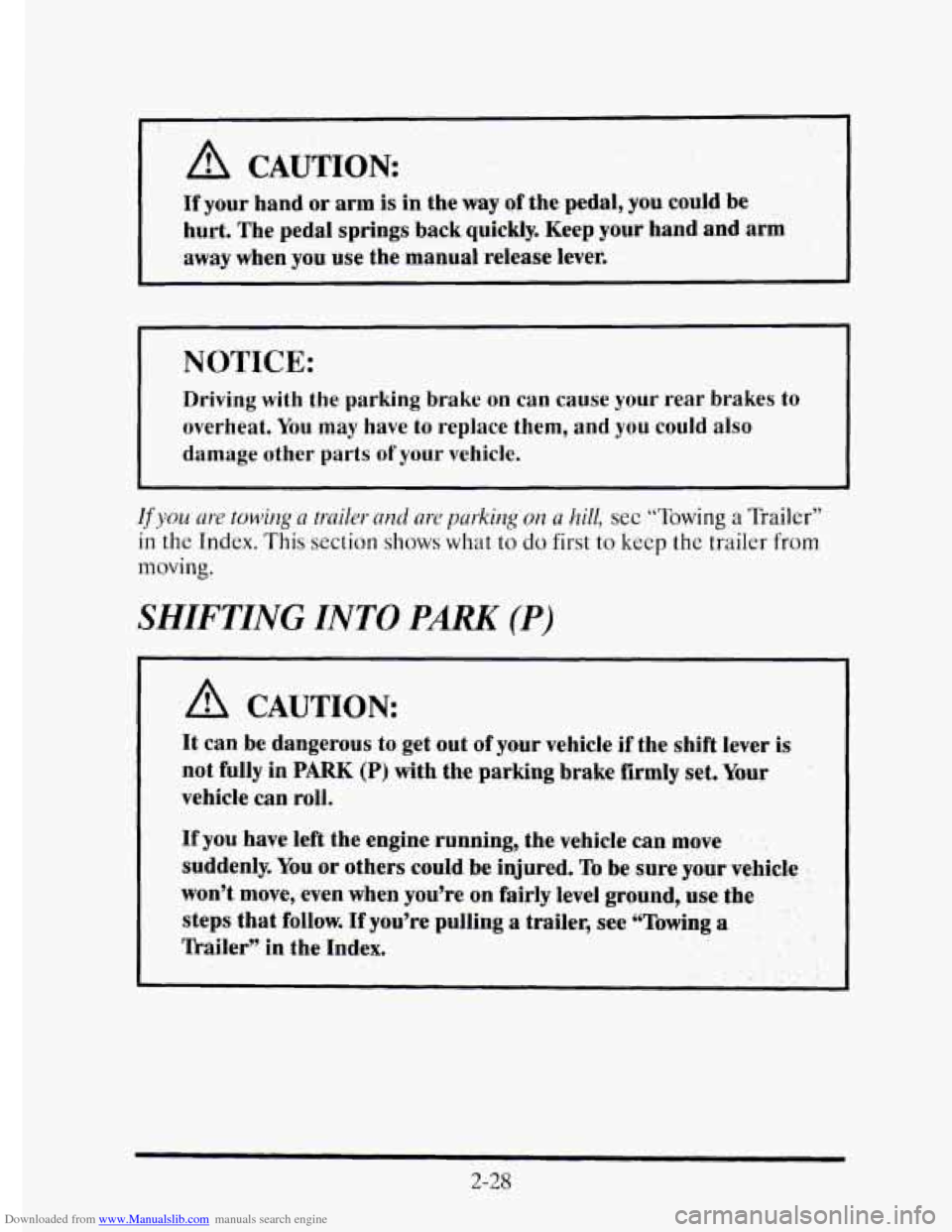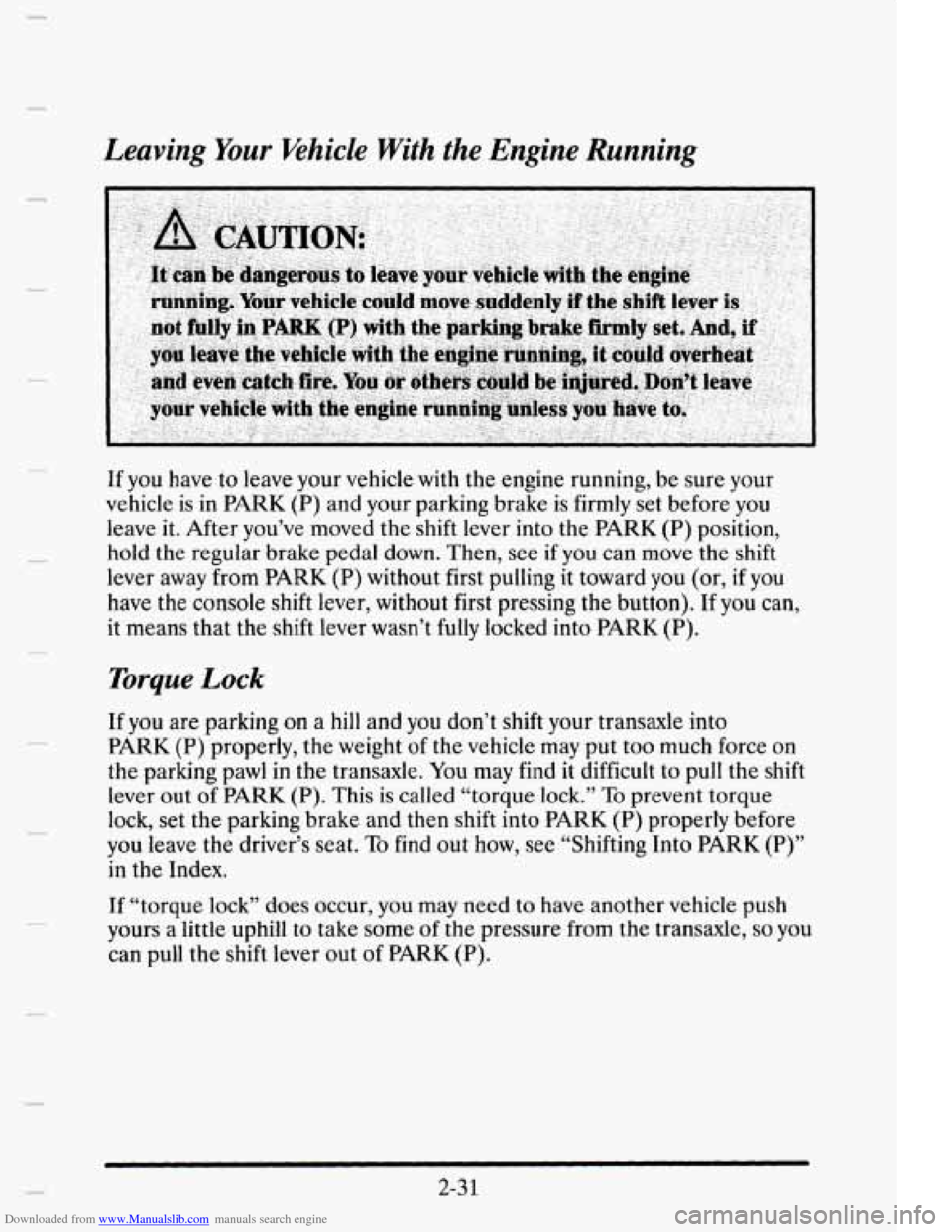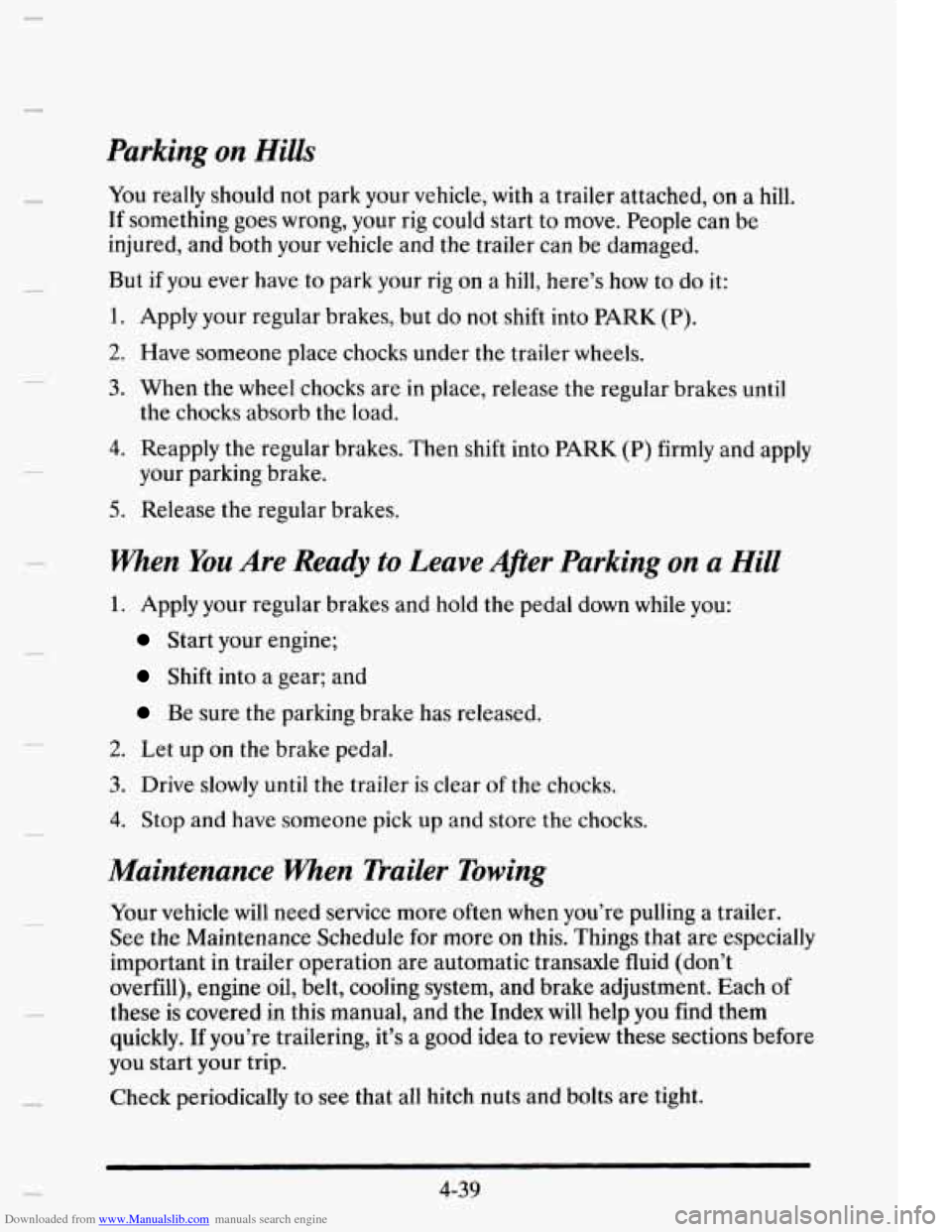Page 98 of 395
Downloaded from www.Manualslib.com manuals search engine -
PMNG BRAKE
To set the parking brake, hold the regular brake pedal down with your
right
foot. Push down the parking brake pedal with your left foot. If the
ignition
is on, the brake system warning light will come on.
When you move out
of PARK (P) or NEUTRAL (N), if your engine is
running, your parking brake should release.
If it doesn’t, you have a
parking brake problem and should have
it fixed. In the meantime, you can
manually release your parking brake as shown by the illustration below.
Pull
on the manual
release lever which
is located
on the
driver’s side under
the instrument panel
and above the parking
brake.
2-27
Page 99 of 395

Downloaded from www.Manualslib.com manuals search engine A, CAUTION:
If your hand or arm is in the way of the pedal, you could be
hurt.
The pedal springs back quickly. Keep your hand and arm
away when
you use the manual release lever.
I NOTICE:
Driving with the parking brake on can cause your rear brakes to
overheat. You may have to replace them, and you could also
damage other parts
of your vehicle.
If you are towirg u truiler and are parking on a hill, see “Towing a Trailer”
in the Index. This section slmws what to do first to kecp the trailer from
moving.
SHIFTING INTO PARK (P)
A CAUTION:
It can be dangerous to get out of your vehicle if the shift lever is
not fully in PARK (P) with the parking brake firmly set. Your
vehicle can roll.
If you have left the engine running, the vehicle can move ’’
suddenly. You or others could be injured. To be sure your vehicle
won’t
move, even when you’re on fairly level ground, use the
steps that follow.
If you’re pulling a trailer, see “Towing a
ll-ailer” in the Index.
.. ...
2-28
Page 100 of 395
Downloaded from www.Manualslib.com manuals search engine Steering Column Ship Lever
1. Turn the ignition key to the OFF or RUN position.
2. Hold the brake pedal down with your right foot.
3. Move the shift lever into the PARK (P) position like this:
~ Pull the lever
toward you.
Move the lever up
as far as
it will go.
4. With your right foot still holding the brake pedal down, set the parking
5. Move the ignition key to LOCK.
6. Remove the key and take it with you. If you can walk away from your
brake.
vehicle with
the ignition key
in your hand, your vehicle is in PARK (P).
2-29
Page 101 of 395
Downloaded from www.Manualslib.com manuals search engine Console Shift Lever
1. Turn the ignition key to the OFF or RUN position.
2. Hold the brake pedal down with your right foot.
3. Move the shift lever into PARK (P) position like this:
Hold in the button on
the lever, and push
the lever all the way
toward the front
of
your vehicle.
A
4. Set the parking brake with your right foot still holding the brake pedal
5. Move the ignition key to LOCK.
6. Remove the key and take it with you. If you can walk away from your
down.
vehicle with the ignition key in your hand, your vehicle is
in PARK (P).
2-30
Page 102 of 395

Downloaded from www.Manualslib.com manuals search engine Leaving Your khicle With the Engine Running
If you have to leave your vehicle with the engine running, be sure your
vehicle is in
PARK (P) and your parking brake is firmly set before you
leave it. After you’ve moved the shift lever into the PARK (P) position,
hold the regular brake pedal down. Then, see
if you can move the shift
lever away from
PARK (P) without first pulling it toward you (or, if you
have the console shift lever, without first pressing the button). If you can,
it means that the shift lever wasn’t fully locked into
PARK (P).
Torque Lock
If you are parking on a hill and you don’t shift your transaxle into
PARK (P) properly, the weight of the vehicle may put too much force on
the parking pawl in the transaxle. You may find it difficult to pull the shift
lever out
of PARK (P). This is called “torque lock.” To prevent torque
lock, set the parking brake and then shift into
PARK (P) properly before
you leave the driver’s seat.
To find out how, see “Shifting Into PARK (P)”
in the Index.
If “torque lock” does occur, you may need to have another vehicle push
yours a little uphill
to take some of the pressure from the transaxle, so you
can pull the shift lever out
of PARK (P).
2-3 1
Page 147 of 395
Downloaded from www.Manualslib.com manuals search engine If the light comes on while you are driving, pull off the road and stop
carefully. You may notice that the pedal is harder to push. Or, the pedal
may go closer
to the floor. It may take longer to stop. If the light is still on,
have
the vehicle towed for service. (See “Towing Your Vehicle’’ in the
Index.)
A CAUTION:
Your brake system may not be working properly if the brake
system warning light is on. Driving with the brake system
warning light
on can lead to an accident. If the light is still on
after
you’ve pulled off the road and stopped carefully, have the
vehicle towed
for service.
The brake system warning light will also come on when you set your
parking brake, and
it will stay on if your parking brake doesn’t release
fully. If it stays on after your parking brake is fully released, it means you
have a brake problem.
2-76
Page 226 of 395

Downloaded from www.Manualslib.com manuals search engine Parking on Hills
c
You really should not park your vehicle, with a trailer attached, on a hill.
If something goes wrong, your rig could start to move. People can be
injured, and both your vehicle and the trailer can be damaged.
But
if you ever have to park your rig on a hill, here’s how to do it:
1. Apply your regular brakes, but do not shift into PARK (P).
2. Have someone place chocks under the trailer wheels.
3. When the wheel chocks are in place, release the regular brakes until
the chocks absorb the load.
4. Reapply the regular brakes. Then shift into PARK (P) firmly and apply
5. Release the regular brakes.
your parking
brake.
When You Are Ready to Leave Afier Parking on a Hill
1. Apply your regular brakes and hold the pedal down while you:
Start your engine;
Shift into a gear; and
Be sure the parking brake has released.
2. Let up on the brake pedal.
3. Drive slowly until the trailer is clear of the chocks.
4. Stop and have someone pick up and store the chocks.
Maintenance When Trailer Towing
Your vehicle will need service more often when you’re pulling a trailer.
See the Maintenance Schedule
for more on this. Things that are especially
important in trailer operation are automatic transaxle fluid (don’t
overfill), engine oil, belt, cooling system, and brake adjustment. Each
of
these is covered in this manual, and the Index will help you find them
quickly.
If you’re trailering, it’s a good idea to review these sections before
you start your trip.
Check periodically to see that all hitch nuts and bolts are tight.
4-39
Page 238 of 395
Downloaded from www.Manualslib.com manuals search engine When your vehicle is being towed, have the ignition key off. The steering
wheel should
be clamped in a straight-ahead position, with a clamping
device designed for towing service.
Do not use the vehicle’s steering
column lock
for this. The transaxle should be in NEUTRAL (N) and the
parking brake released.
Don’t have your vehicle towed
on the front wheels, unless you must. If the
vehicle must
be towed on the front wheels, don’t go more than 35 mph
(56 km/h) or farther than 25 miles (40 km) or your transaxle will be
damaged. If these limits must be exceeded, then the front wheels have
to be supported on a dolly.
5-1 1